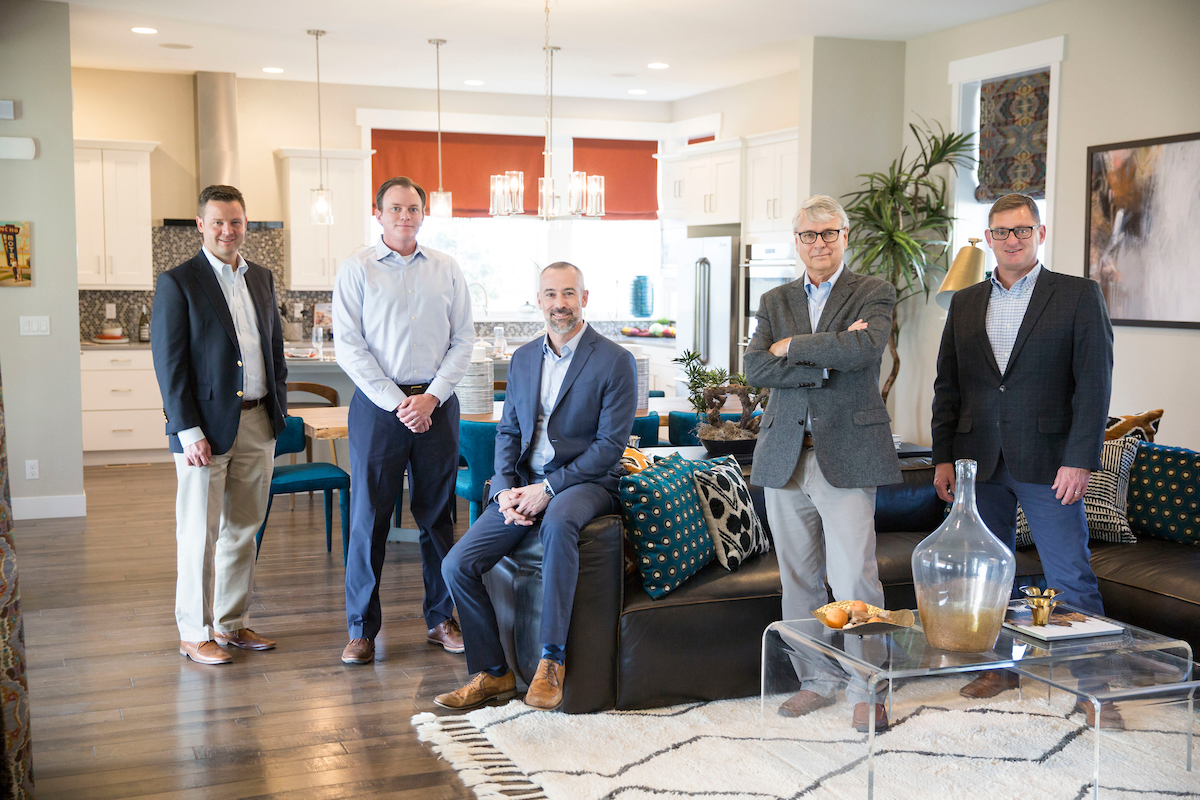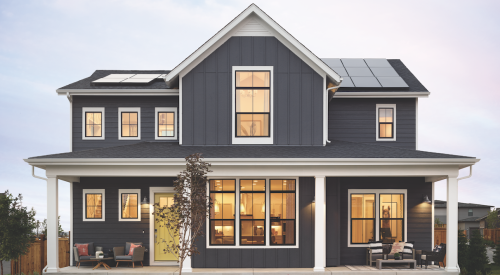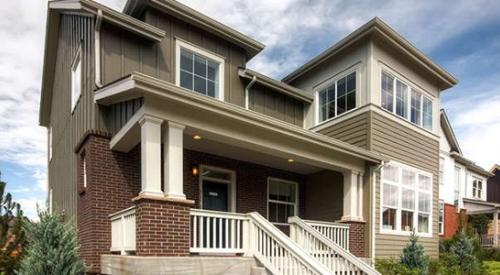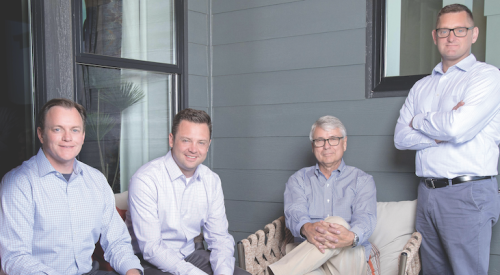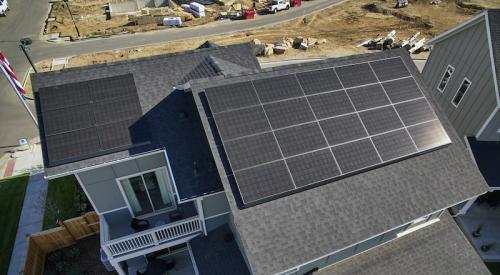The world is a messy place.
That’s the mantra Thrive Home Builders employees frequently hear from CEO Gene Myers. In the home building microcosm, it means that even the most thorough scopes of work, comprehensive process mapping, and robust scheduling software cannot prevent overlooked pinch points, anticipate interruptions, or identify unintended consequences.
But a collaborative culture can fix a chronic mess. As an example, take the several townhouses that Thrive had built in its Elements Collection, in Stapleton, Colo. In those homes, the placement of the furnace in the upstairs mechanical room drifted from house to house, depending on joist spacing. Project managers repeatedly dealt with the nuisance of finding a spot for the furnace that would allow proper clearance for plumbing and the tankless water heater.
The problem was pointed out to Eric Sung, director of product development and Thrive’s in-house architect, during one of his weekly visits to the jobsite. High-performance and healthy home manager Nathan Kahre and director of purchasing Jenna Maxwell and her staff also make jobsite visits a regular practice to look for shortcomings in specs or scopes of work details and their application at the construction site. Sung is brought in for cases such as the furnace situation, when blueprint details just don’t work in the field. In that instance, having identified the problem, Sung designed out the variability in the plan used by the framers by changing the second-floor joist layout from 24 inches on center to 19 ½ inches. That adjustment enabled the furnace to be positioned tight to the wall, creating more room in the mechanical closet.

Operations start and end at the whiteboard. “There’s a ridiculous amount of information,” says operations VP Bill Rectanus, with Deia Vonfeldt, construction operations manager. “We can just walk in here and see where there might be a problem.”
A collaborative culture also can move dirt. Danny Knight, a project manager for the Denver builder, had hills of earth to get rid of after completing stormwater and erosion control excavation on a Stapleton townhouse project. He had arranged with a Thrive project manager who was building single-family homes in another section of the community to take the dirt. However, that manager’s excavating contractor went out of town and couldn’t remove the dirt by the scheduled date. Knight was stuck with a mound of problems and a potentially stalled project.
When Knight mentioned his dilemma during the weekly huddle—the regular Tuesday morning meeting where all departments gather in Thrive’s downtown office to update staff about projects and check the status of building cycle targets—another project manager jumped in, saying he had lots available where the dirt could be dumped and stockpiled. Problem solved, and the huddle (or “Great Huddle,” as the company calls it) served its intended purpose as a meeting where employees share problems and work out solutions without senior managers hovering over them or demanding that the remedy be approved by the chain of command.
ON THE VANGUARD
The Thrive culture, layered with differentiated product and compelling marketing that connects the benefits of wonkish building science to how Thrive homes improve their owners’ lives, has helped this small regional fish stand out in a pond where bigger, national fish swim. Thrive is constructing homes that meet the requirements of the U.S. Department of Energy’s Zero Energy Ready Home program, so the houses produce as much energy as they consume, with double-stud, 9 ½-inch-thick, R-41 blown-in fiberglass walls and indoor air quality certified under the EPA’s airPLUS program. And the green and healthy benefits are available not just to wealthy buyers through luxury plans such as the mid-century modern Sanctuary, priced as high as $1 million with an ERV delivering high air-filtration rates and a Tesla Powerwall storing energy generated by solar panels. Income-qualified buyers can also purchase a Net Zero-certified, solar-ready home, such as the two-bedroom townhouses in the Elements Collection, starting at $199,000.

Thrive opened its first ZEN (Zero Energy Now) models at Stapleton in Fall 2013, and the homes have been the basis for its energy efficiency work ever since. Homes in the ZEN 2.0 Collection range from 2,098 to 2,541 square feet.
Thrive has taken high-performance housing to the next level. It is a six-time Grand Winner in the DOE’s annual Housing Innovation Awards, which honors outstanding Zero Energy Ready homes. Two of those awards came this year for entries in the multifamily and production home categories. Even more auspicious: In an industry dominated by the marketing sameness of builder after builder advertising quality, price, location, and value, Thrive developed a brand. Its three attributes—efficient, healthy, and local—seamlessly tie in with the tagline “Homes That Do More” and connect consumers to the experience, not the features, of living in a Thrive home.
Professional Builder’s 2017 Builder of the Year may still be a small fish, but numbers reveal that Thrive is getting ever closer to the company goal of being financially sound enough to weather the next downturn and be an active land buyer in 2020. Senior managers picked that year because that’s about when Stapleton, Thrive’s bread-and-butter community since 2002, will be built out. Since 2014, Thrive’s revenue more than doubled from $51.8 million to a projected $113 million this year, and is up almost 22 percent above last year. Closings also are expected to double and finish 2017 at 224 units, compared with 121 in 2014 and 193 last year. Houses sold this year are expected to tally a projected 257, up from 88 in 2014 and 188 last year.

Thrive's Vita Collection models at Stapleton include finished basements and generously-sized pantries. They're the first homes in which the builder installed energy recovery ventilators (ERVs). The homes range from 1,798 to 2,566 square feet.
“Our approach with our people is a shared desire to build a company of financial strength to prevail in all market conditions,” Myers says. “We have so many employees that have lived through the recession, and it’s almost an indelible scar. It’s like they’re not getting over it.”
|| Values as Incentive ||
Most of Thrive Home Builders’ lead salespeople come from other home builders, with a background in sales. But selling at Thrive is different. “This isn’t a competitive floor,” says Elitia Schwaderer, Thrive’s director of sales. “It’s uncomfortable for the employee, as well as for the customer.” Models are staffed by a Community Sales Manager who serves as lead salesperson, and a Community Sales Assistant who provides support and backup (many eventually move into a sales manager role). The two work collaboratively; the Sales Manager receives a percentage and the Sales Assistant gets a flat amount. “You’re invested in everyone who walks through the door,” Schwaderer says.
A veteran of high-pressure sales (“You’re on vacation, stressing about whether a colleague is going to steal your customers”), Schwaderer started at Thrive as a Community Sales Manager. “It goes beyond sitting in a pretty garage, showing and telling all day,” she says: Thrive salespeople are involved in all aspects of a community’s operations. Schwaderer seeks candidates who get excited about Thrive’s tenets of efficient, healthy, and local; who live that way themselves; and who can be as committed an advocate for Thrive as they are for the homebuyer. “If someone tells me, ‘I’ll do whatever it takes to make the customer happy,’ I know it’s not a good fit,” she says.

Elitia Schwaderer, director of sales (left), and Susan Elovitz, director of marketing (right), consult with CEO Gene Myers. Elovitz describes Thrive's marketing of sustainability as having evolved to "say more by saying less."
But the high standards that permeate Thrive culture are also present in sales operations. Schwaderer, recently named Sales Manager of the Year in Denver’s MAME awards, says “Goal-setting has been huge in helping our team step outside of their comfort zone,” mentioning Jason Forrest’s Warrior Selling as a training tool. Forrest’s program uses the Six Human Needs—certainty, variety, significance, love/connection, growth, and contribution—originated by life coach Tony Robbins and based on Maslow’s hierarchy of needs, to train salespeople in communicating Thrive’s value proposition and overcoming objections. Schwaderer also trains her staff to use those guidelines to help prospects determine if building a Thrive home is right for them.
So far, Schwaderer has recruited three top salespeople from a national builder. “It’s not the car, it’s not the trips; it’s showing how different we are,” she says. “Our culture is the incentive.”
SPAGHETTI AND SUSTAINABILITY
Early during the economic recovery, Myers started a company tradition of cooking spaghetti dinners for employees at a model home. The first such dinner took place following an IBACOS conference where Keith Porterfield, COO of Goodall Homes, Professional Builder’s 2014 Builder of the Year, gave a presentation about how the Gallatin, Tenn., builder’s profitability grew during the recession. Porterfield credited that success to adopting open-book management; a culture where company leaders regularly share financial statements and performance metrics with employees, who are coached to act like owners. Employees, in turn, are empowered to be proactive and entrepreneurial in solving problems and attaining goals because they have a stake, usually through profit sharing or bonuses, in the company’s success. During the dinner, Myers asked employees about their greatest fear for their careers. “2008,” one veteran project manager blurted out.
The builder went from more than 75 employees at the height of the boom to 13 during the bottom of the recession, while closings fell from 200 to 35. Myers’ response to that employee’s comment: “If you’re not concerned about job security, you weren’t paying attention through the recession—and what on earth can a small fish in a big pond do about that?” He adds, “I feel that if we are fully engaged and empowered, we stand a better chance of building a company of the financial strength to prevail in all market conditions. I can’t promise it will work, because the world is a messy place. But I can promise that if we fail to work on it at the top of the market, I know what will happen at the bottom of the market next time, and I don’t want to be the builder that uses up [employees] in the good times and kicks [them] to the curb at the first sign of trouble.”
Adopting an open-book management approach was the moment at which Myers won the hearts and minds of the company’s employees to move everyone in a direction they had never gone before.
DECADES ON THE CUTTING EDGE
The company’s story began in 1992 when, after several years working as a civil engineer, Myers launched Greentree Homes. The semi-custom home builder soon sought ways to stand out from competitors that built on large lots amid the pine trees. Greentree popularized Craftsman-style architecture, which no production home builder at the time was doing, and debuted bolder colors in the Forest Park community, at a time when Denver’s new residential construction was dominated by rose and beige exteriors. Greentree was also an early adopter of sustainability and built to the Energy Star certified homes standard. Myers trademarked the phrase “Eco-Built” and guaranteed savings on his customers’ annual heating bills.
“When I look back on successful projects and why they were successful, I conclude it was because we had some really amazing lots, and that’s hard to replicate,” Myers says. “You can’t always have the best lots in a submarket.”
Again looking for an edge, Myers sought to differentiate through architecture and land design. He launched New Town Builders in 1999 to reflect a focus on New Urbanism. A development opportunity in Denver’s Commerce City neighborhood eventually came on the radar. Landcraft Communities sought a partner to redefine the suburbs with a community that integrated different housing types and mixed incomes. New Town was recruited. With architect Arlo Braun, Belle Creek broke ground in 2000 and became an affordable housing village with 900 housing units and a sense of place. New Town’s single-family houses with quaint front porches were the streetscape image featured on the cover of The New Shape of Suburbia, published in 2003 by the Urban Land Institute. The book profiles 11 communities that broke out of the one-size-fits-all subdivisions prevalent in the 1970s and ’80s through designs that increased density to open more green space and with walkable, mixed-use districts. The New Town houses also won the 2002 Gold Nugget award for Best Affordable Detached Housing design.
|| Focus on Indoor Air Quality ||
Thrive Home Builders has been building to the EPA Indoor airPLUS standard since 2016, but selling the homes now includes a proactive approach on health. The data are sobering. The EPA counts indoor air pollution as one of the top five environmental health risks, due to dust, mold, animal dander, particulates from appliances, vehicle exhaust, and volatile organic compounds (VOCs) from building materials and furnishings. Most of us receive three-quarters of our chemical exposure at home.
Radon is the second largest cause of lung cancer in the U.S. Most of Colorado and all of Denver metro are classed as Zone 1, the EPA’s worst rating. Thrive follows radon building best practices, measures radon before occupancy, and installs an active radon mitigation device in every home.
Formaldehyde can worsen asthma symptoms and has been identified as a carcinogen. Thrive builds using third-party certified low-VOC materials, including CertainTeed’s AirRenew drywall; increases home ventilation; and promotes healthy cleaning products to its homebuyers.
Ozone is a respiratory irritant, and Denver gets a bad EPA grade here, too. Thrive builds a tight envelope to prevent ozone entry, doesn’t install equipment that generates ozone or other reactive chemicals, and provides information about outdoor ozone conditions through social media.
Asthma and allergy triggers get a prime focus with moisture control for mold prevention and the latest in home ventilation, air filtration, and ecologically sound pest management. (Among school-age kids, asthma is one of the top reasons for days missed.)

Nathan Kahre gets a readout from a capture hood, used to measure air coming out of a vent, and to double-check HVAC installation.
Nathan Kahre, high-performance and healthy home manager at Thrive, has spearheaded much of the builder’s research on indoor air quality. “Yes, we ventilate, and yes, we do proper installations, but the last frontier when it comes to health is letting all of our homeowners know that we want to be their partner for continuing to have a healthy home.”
EARLY ADOPTER
The builder continued raising the bar on energy efficiency after Belle Creek. In 2009, during the recession, when competitors were discounting, New Town chose to stand out by making solar energy panels and hookup standard. “We gave it away,” Myers says. “That was our concession, but we knew [buyers] couldn’t get it anywhere else. So we felt like that was the strong product differentiation we needed to survive.”
Standard solar also was the catalyst for New Town to dive deeper into high-performance home building. Myers and Bill Rectanus, VP of home operations, researched several energy codes. They selected zero net energy as their standard to build to. A prototype net zero energy house was built in 2011 on a vacant lot in Stapleton. Framing with double 2-by-4 walls began that same year, and New Town devised a logical marketing appeal to counter the lower priced code-built homes, telling prospects that if they pay $100 more in their mortgage for a net zero home, they’ll get $300 per month in savings on their energy bill. Despite much fanfare in the press and a visit from U.S. Senator for Colorado Michael Bennet, who had just introduced legislation directing federal mortgage loan agencies to consider expected energy-cost reductions when making loan-qualification calculations, New Town sold just one home.
“I would say that this happens often in our innovation process, where you come up with an idea, you launch it, and it just lands with a resounding thud,” Myers says. So New Town rolled the dice and preplanned building homes with a forced net zero option on half of the originally intended plots. If the product didn’t sell, New Town could capitulate on the other lots and drop net zero. But more than a third of the net zero lots were bought.
COMMITTING TO NET ZERO
Later, Myers, who himself lives in Stapleton, was at one of the company’s Meet Your Neighbor gatherings where managers rub shoulders with homeowners and customers who are under contract. The gathering helps promote to clients that their builder is a local just like they are. It also serves as informal research about buyers. There Myers met a Baby Boomer couple who told him they weren’t in the market to buy another house, but when they heard net zero energy houses were available, they came to look and bought. “I’ve never had a product that would take someone who is not in the market and motivate them to come buy what we build,” Myers says. From that experience, he came to believe that net zero actually had legs.
New Town had a clean slate of lots at Stapleton to construct more net zero house designs. It collaborated with Owens Corning to insulate its way to zero energy and help market the benefits of a tight house with thick walls of insulation. The builder also recruited Tyvek manufacturer DuPont to train subcontractors to properly wrap houses and sent inspectors to see that those jobs were done to the manufacturer’s specifications. As New Town pursued a higher energy code, the builder also worked with Panasonic Ventilation to construct homes with fewer pollutants and contaminants, before eventually certifying them under the EPA’s indoor air quality program, Indoor airPLUS.
“We’ve been doing Indoor airPLUS for years because it’s integral to the Department of Energy’s energy-rating program,” says Stephen Myers, VP of process control and improvement. “And yet, talking about health was something that we were maybe a little reticent to do. Has anybody done research yet that unequivocally says that if you move into this house with these features, you will be a healthier person?”
In 2013, New Town Builders opened the first models in its Z.E.N. (Zero Energy Now) collection and established itself on the leading edge of high-performance home building. But even that lead is fleeting. As code requirements become more stringent and more competitors build net zero energy ready houses, managers realized that advantage would narrow. Also, the company’s adoption of energy-efficient innovations occurred under the New Town banner, a name that reflected the urban planning vision Myers accomplished at Belle Creek. Now the name was meaningless to homebuyers. Myers could stake a position heavily on sustainability, but how to sell it? Even though the energy savings from a net zero house are substantially more exciting than the $30 to $40 monthly payback for houses built to less-stringent energy codes, that benefit had to compete against other features that customers, particularly those who were on the fence about green, would rather spend money on, such as finish upgrades.
|| Wonder Wall ||
A collaboration between Thrive and the University of Minnesota’s Cold Climate Housing Program, with a grant from the Department of Energy’s Building America Solution Center, the Monopath Wall System, aka “the tall wall,” is an 8-by-24-foot OSB perimeter wall system.
Fewer seams ensure increased efficiencies for energy and labor. Corners go in first, assembled with a screw gun. The Monopath is then lowered by crane and installed horizontally for a two-layer wall that’s 2 ¼ inches thick, assembled with glue and screws. Doors and windows are cut in, second-floor joists are assembled, and the second floor is then sheeted.
The result is a solid shell with no two-by-fours and no cavities for plumbing or insulation. “It’s extremely strong, but you can’t stop there,” says Thrive CEO Gene Myers, who describes the next steps: a peel-and-stick moisture barrier added to the panels’ exterior, followed by the application of rigid foam insulation, and then siding. “The structure is always warm on the inside, with no condensation, mold, or structural deterioration from moisture,” Myers says, noting that taking care with window flashing is crucial.
At a Habitat for Humanity project in Minneapolis, a Monopath tall wall is installed (Photo: Gene Myers)
“The University of Minnesota has worked on this for 14 years to judge if it’s market-ready,” Myers says, mentioning fewer pieces and parts, less room for error, and a tighter envelope. Given weather challenges and labor shortages, the potential for getting a house enclosed and quickly ready for wiring is enormous. “A production framer could potentially frame a house in a day using this system,” Myers says.
Thrive will field-test the wall on four single-family homes during the next year. “It’s not routine for the building department, and that’s another aspect of market-readiness that needs working through,” Myers notes. But the Monopath could potentially save builders between $10,000 and $20,000 per home in construction costs, and Myers is cautiously optimistic. “There are incremental steps that can be taken,” he says. “This might be one of them.”
FINE-TUNING STRATEGY
“We didn’t want to leave efficiency behind. We are still a [net-]zero energy builder,” says Susan Elovitz, director of marketing. “We’ve been the most innovative builder in the country for five years in a row. We won the innovation and housing award, and we used that to promote ourselves, and we made solar standard. We were still that builder, but we wanted people to know that we’re more than that.”
The 9 ½-inch walls were the most visible feature that helped New Town salespeople tell customers New Town’s energy efficiency story. But the builder knew it couldn’t guilt-trip customers into buying green. Besides, New Town had more to talk about than just energy efficiency.
The company had been building airPLUS-certified homes, for example, but hadn’t really promoted it. Another practice near and dear to locals is New Town’s policy to use beetle-kill lumber for framing. Over the past 20 years, the mountain pine beetle has destroyed an estimated 3.4 million acres of lodgepole and other pines in Colorado’s high elevations, leaving dead standing trees that would become kindling for devastating wildfires if not harvested. And, through the Meet Your Neighbor gatherings, clients saw that their builder lived in the community just like they did and wasn’t a national company that could pull up stakes tomorrow.
Rather than take credit for every sustainable feature included in the house, as many high-performance home builders tend to do, New Town just needed to let the customer know enough details to make a purchase. Besides being energy efficient, New Town already had the attributes of healthy and local. So the builder rebranded as Thrive Home Builders in 2015. “We tried to say more by saying less,” Elovitz notes.
Management eventually settled on the tagline: “Homes That Do More,” a slogan that easily adapts to convey Thrive’s brand position and attributes: “Your home should help pay your energy bill. Ours does” (energy efficiency); “Your home should make you healthier. Ours does” (healthy homes); “Your home should be built by your neighbors. Ours are” (local); and the aspirational brand position, “Your home should help you thrive. Ours does!”
BUYER OPTIONS, SIMPLIFIED
Another part of rebranding involved reducing the more than 22,000 SKUs from Thrive’s selections catalog by closing its design studio. Options were curated into five groups of design preferences—Base, City Loft, Urban Farm, Modern Chic, and Casual Elegance—each one further delineated into cool or warm tastes. The samples for cabinets, tile, flooring, and counters are neatly displayed in the uncluttered Design Technology Studio set up in the garage of model homes. Gene Myers was inspired to make the change after attending a presentation by Alaina Money, then a division president for Garman Homes, a production home builder in Durham, N.C., that lets buyers personalize their home by picking whole-house design packages rather than choosing individual options.

Jenna Maxwell, director of purchasing (standing), consults Thrive's centralized database with purchasing coordinator Kirsten Dolan. Packaging buyer options is a key strategy.
The studio made the selections process more manageable by not overwhelming customers with too many choices and appointments with designers. More houses started with complete selections packages. Because the choices were limited to consistently available items, there were fewer delays caused by back-orders for out-of-stock products. The new process allowed Thrive to get rid of hard-to-install tile, flooring, and other items that prompted callbacks, delays, and extra costs. Streamlining selections also demystified the building process because Thrive could tell clients how much their home with the whole-house selections package would cost.
“There’s nothing cool about hiding the ball from people by telling them what the house is going to cost and then gouging them at the design center,” Myers says. “What you’re trying to do throughout the sales process is reduce uncertainty. Uncertainty is the enemy in any transaction, and we want to build trust. The traditional design center approach, we feel, does the opposite.”
MERCHANDISING AS EDUCATION
Merchandising in the Design Technology Studio is where prospects see all they need to know about the building science in a Thrive home. The “If these walls could talk …” display shows a waist-high cross section and top-down view of the thicker, double-stud wall filled with loose insulation next to a thinner conventional 2-by-4 frame. A poster on the Power of Efficiency shows the evolution of lighting from candle to incandescent bulb to CFL and LED, reminding visitors about investing in tomorrow’s technology instead of yesterday’s. A Tesla battery pack and an inverter connected to solar panels are mounted on another wall. The displays help salespeople delve deeper with clients into details such as HERS ratings, R-values, air exchanges, radon ventilation, and kilowatt usage. “The wall section is still, from a sales perspective, probably the most valuable thing that we do because it’s just one of the few energy-efficient features that’s visible. Everything else is invisible,” Kahre says.
MEETINGS THAT MATTER
But even the best marketing plan is worthless without effective execution. The Great Huddle, scheduled for every Tuesday morning in the training room at Thrive’s headquarters, is where execution begins. However, even there, managers and employees would leave the sessions without a firm grasp of the big picture, since the discussion would focus on what was happening with just a few key homes.
That all changed last summer when, at the recommendation of business consultant George Casey, Rectanus created a visual tool in the form of whiteboards. Rectangular magnets representing lots and house projects are put on closing dates on a 120-day calendar. The board has a color-coded key that reveals what the dot sticker on the rectangles means: green is a lot that can only go to foundation until it is sold; blue is a model home; yellow is a spec home; and a red dot means something is missing from the perfect start program. A “perfect start” means that before the foundation is dug, all selections are made, permits are pulled, and paperwork is complete. A sideways rectangle means the lot has been excavated, and a blank one denotes that a lot is available for start.

"Our motto is, 'We always do the right thing; good, bad, or indifferent,'" says John Rojo, Thrive's customer service manager, who relies heavily on his team's good judgement.
Sales, construction, purchasing, and customer service people are all in the room at the Great Huddle meeting and deal with the red dots on a house-by house-basis. Another board puts the houses in production buckets, so at a glance, the board shows which projects are waiting for foundation, framing, plumbing, and HVAC. If a house isn’t on track to hit its closing date, a discussion ensues about how to get it back on target. If that can’t happen, the magnet is pushed into the next month—a move not taken lightly.

Opting for open-book management was "a teaching moment," recalls CFO Jeff Seibold. "We started at a house level," he says, so information was easier to absorb for those unfamiliar with balance sheets and income statements.
During a discussion about pushing back completion of an Elements townhouse in Central Park, project manager Evan Matthews made an impassioned plea about how postponement would affect the lives of an income-qualified mother and her family who had been sleeping on the couches of relatives for the past two months while waiting to move into their new home. Another example of how construction managers brainstorm to meet or beat the annual production plan is the spreadsheet developed by project manager Knight, which provides a running monthly snapshot of where a project is, from its slotted date to its projected closing. At a glance, fellow managers can see if a house is running behind or on schedule. That tool helped construction managers move nine houses originally slotted for 2018 to close this year.
ACCOUNTABILITY VS. FINGER-POINTING
The collaborative culture leads to what Rectanus and Gene Myers call “enlightened decision-making.” Moving a whiteboard magnet embodies an element of group accountability because changing the original closing affects company goals and potential bonus payouts. Discussing why a project is behind schedule, with all players in the room, can reveal whether a buyer or lender, a construction or communication issue, or some other snag needs to be addressed.
But accountability can turn into finger-pointing. So Thrive follows ground rules for discourse in any company meeting that are loosely based on Maslow’s Hierarchy of Needs—a motivational theory in psychology proposed by Abraham Maslow comprising a five-tier model of human needs. Above-the-line behaviors—improvement, challenge, and mastery—that foster positive outcomes are encouraged. Those that fall below the line—playing not to lose, cruising, and competing by tearing down others—are frowned upon and require that the offender toss a dollar into the below-the-line jar.
“There are no egregious violations here, but someone might say, ‘I’ve got to go below the line,’ and they’ll make a joke or some one-off comment about a situation and throw a dollar in the jar,” Rectanus says. “We have fun with it, but it really has elevated the thought and conversation within the company because people are thinking about: How do I attack this problem without going below the line?”
|| Giving Back and Gaining Employees ||
Thrive is an engaged participant in many community causes, donating more than a million dollars worth of time and homes to HomeAid; Habitat for Humanity; metro Denver’s Home Builders Association; environmental building alliances including the Energy & Environmental Building Alliance, Housing Innovation Alliance, the DOE’s Race to Zero and Solar Decathlon; and Douglas County libraries, Lone Tree Arts Center, and Tall Tales Ranch.
But the Challenge Foundation, a nonprofit that offers educational opportunities to students in need, which was founded by a former contractor, is of special interest to Myers. Some 200 fifth-graders across Denver are identified by their school principals as having top potential; of those, 35 attend a summer enrichment program. From that group, Myers helps select 10 students to become Challenge Scholars, receiving free tuition to the best college preparatory schools in Denver. He’s also a mentor in the program. If needed, Challenge helps meet unforeseen needs, such as transportation, tutors, clothing, sports equipment, and advocacy for the student’s family. Challenge stays with the scholar through college, and about 90 percent graduate. “It’s unlike anything I’ve been involved with before,” Myers says. “We’re just all in for these kids.”
Two Challenge Scholars have come to work for Thrive. One, a college senior majoring in finance, has been an intern for two consecutive summers. Another, Gustavo Morales, was hired full time this past summer. Morales graduated from Gonzaga University this year with a mechanical engineering degree and serves as project engineer. The position, which was created for him, deploys his knowledge of home building, his technical skill at using Thrive’s new centralized scheduling system, and the fact that he is bilingual. “We needed someone to mine the data, minimize dry runs, and to assist with shortening our construction schedule,” Myers says. “The worst construction day is when nothing is happening. Gustavo works to minimize those days.”
CONTINUAL SOUL-SEARCHING
Not long ago, a developer in Austin, Texas, invited Thrive to build a community of high-performance homes there. Thrive’s senior managers checked out the land but ultimately decided Austin would be a distraction, and that the company wasn’t yet operationally strong enough to open in a second market. After all, the world can be a messy place. But, closer to home, Fort Collins, Colo., is being considered for an expansion opportunity. That market is close enough to perhaps not require a huge satellite office, but it would still need local support from people there who can stand on their own. Fort Collins could serve as a test to see if Thrive’s operational excellence has reached the point where it can expand.“Gene always said that we’ve built great houses, but we have not yet built a great company,” Rectanus says. “We’re hoping very soon that we can tell Gene he can no longer say that because we’ve worked hard in the last couple of years to build a great company through focusing on operational excellence.”
